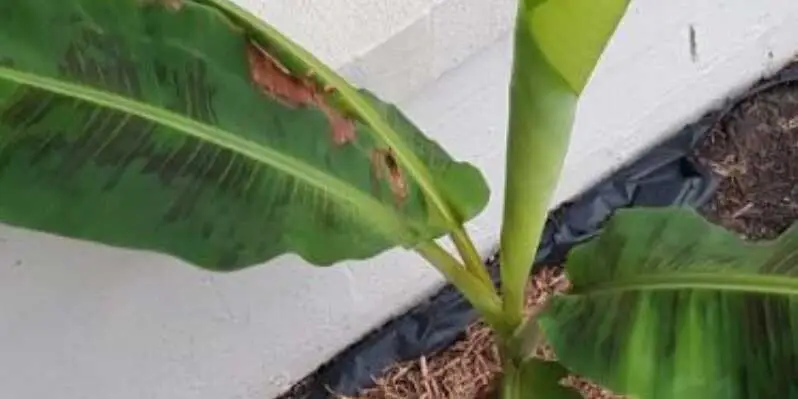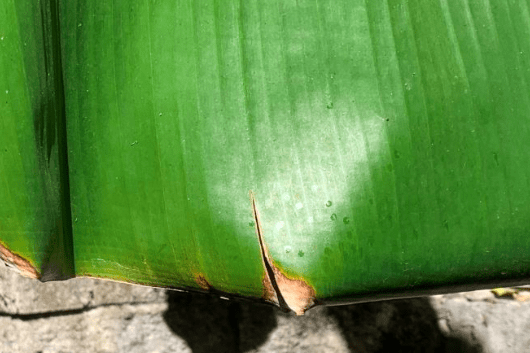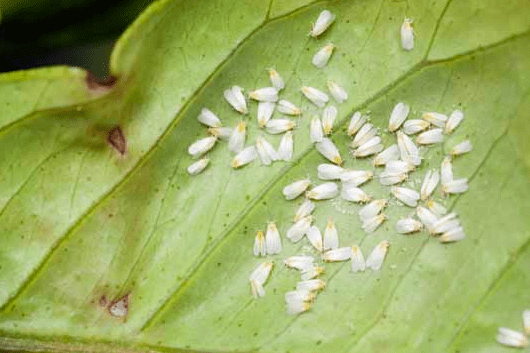Banana plants are a popular choice for gardeners and home growers, due to their attractive foliage and easy maintenance. However, if you have noticed that the leaves of your banana plant are turning brown on the edges, there may be cause for concern.
In this post, we will explore some of the common reasons why banana leaves may be turning brown, as well as tips and strategies for preventing further damage and promoting healthy plant growth. Let’s get started!

Why Are Banana Plant Leaves Turning Brown on the Edges?
The edges of banana plant leaves turn brown when the plant doesn’t get enough water, receives too much sun, doesn’t get the correct nutrients, experiences damage from cold temperatures, has a fungal disease, is being attacked by pests, or is discarding old leaves during the aging process.
Any one of these factors can cause the browning of the banana plant leaves. The exact type of browsing your plant experiences will depend on the exact cause of browsing. For example, if your plant is sun-scorched, you may notice crispy, dry leaves, while if your plant is nutrient-deficient, it may develop yellow or pale brown areas along the edges of its leaves.
Not Enough Water
Just like other plants, banana plants need regular watering in order to stay healthy and vibrant. If you are not providing your plant with enough water, the leaves may start to turn brown along their edges as they dry out.
One way to prevent this from happening is to make sure that your plant always has access to plenty of water. You can do this by regularly checking the soil moisture levels, and adding water as needed.
Simply dip your finger an inch or two into the soil, and if it feels dry, then it’s time to water your plant. Additionally, you may also want to consider adding mulch around the base of your banana plant to help retain moisture in the soil.
Sun Scorch
While banana plants love receiving sunlight, too much sun exposure can actually cause them to become scorched and dry out, leading to the browning of leaf edges. It’s just like when we head to the beach on a hot, sunny day – if we get too much sun without reapplying sunscreen, our skin starts to burn.
To prevent this from happening with your banana plant, you should make sure to position it in an area of your yard that gets plenty of sunlight but is also protected from harsh rays. For example, you might consider planting it in a spot that is shaded by large trees or covered with a garden canopy.

Inadequate Nutrients
Banana plants require certain nutrients in order to stay healthy, including nitrogen, potassium, phosphorus, calcium, and magnesium. If your plant does not get enough of these nutrients due to poor soil quality or other factors, its leaves may start to turn brown or yellow along the edges.
One way to prevent this from happening is to make sure that your plant gets regular fertilization treatments, either by adding fertilizer directly to the soil or using a foliar spray. You should also consider testing your garden soil and amending it with any necessary nutrients as needed.
Using a testing kit will reveal what nutrients your soil is lacking, allowing you to take the necessary steps to add them in. pH testing kits also help to ensure that your soil has the proper pH level for optimal banana plant growth.
Damage from Cold Temperatures
Banana plants are tropical plants, which means that they do not tolerate cold very well. If you live in a climate where temperatures drop below freezing during winter months, it’s important to make sure that your banana plant is protected, which may mean overwintering your banana plant.
To prevent damage from cold, you can either bring your plant indoors or cover it with a protective winter blanket. Additionally, you may also want to consider adding mulch around the base of your banana plant in order to help insulate and protect it from the cold.

Natural Process of Aging
As banana plants age, they naturally start to shed old leaves. While this may seem alarming, it is completely normal and does not indicate that anything is wrong with your plant. In fact, losing old leaves actually serves an important function in the growth of your banana plant – it helps make room for new leaves to emerge.
This tends to happen at the end of the growing season when most banana plants are getting ready to go dormant for the winter. We covered what to do earlier, so scroll up this page if you need a refresher!
Disease
Banana plants are susceptible to a number of different diseases, including fungal diseases, bacterial diseases, viral diseases, and even nematodes. If your banana plant becomes infected with one of these diseases or pests, it may start to turn brown along its leaf edges as the disease progresses.
If your banana plant develops brown spots, then this may be a sign that it has been infected by bacteria or fungi. To prevent this from happening, you should take steps to protect your plant from insect infestations and other diseases by using appropriate pesticide treatments and keeping the area around your plant free of debris.
Additionally, regular pruning can also help keep disease at bay by removing dead leaves and branches, which reduces the risk of disease spreading to other areas. Fungus thrives in moist and humid conditions, so making sure to maintain good air circulation around your plant is also important.
Transport Shock
When you bring a banana plant home from the nursery or garden center, it may experience some shock during the process of transport. This is especially likely if your plant has been exposed to extremes in temperature or humidity levels, like being outside on a hot day and then being brought indoors where it’s much cooler.
To prevent this from happening, make sure to give your plant plenty of time to acclimate and adjust to its new environment before you subject it to any extreme conditions. Additionally, you should always make sure that your banana plant is properly watered and has enough shade or cover from direct sunlight in order to prevent heat stress.
This can happen when people bring their banana plants inside for winter. You see, people think that the more warmth you give a banana plant, the better. But in reality, dry heat from indoor heating systems can actually be really harmful to banana plants.
Pests (Whitefly)
Finally, one of the most common causes of browning along the edges of banana plant leaves is an infestation from pests such as whiteflies. These tiny insects feed on the juices from your banana plant leaves, causing them to turn brown/yellow and eventually dry up and die.
Whiteflies are tiny, white, moth-like insects that are commonly found in indoor houseplants. They move in groups and tend to stick together in clusters on the undersides of leaves.
Whiteflies can be difficult to get rid of, especially if they have already established themselves in your banana plant. However, there are a number of different treatments that you can try, such as using insecticidal soaps or neem oil.
I’ve found great success when spraying neem oil directly onto the leaves of my banana plant to kill off any pesky whiteflies. Be sure to do this at least once a week, and you will soon see your banana plant’s leaves returning to their healthy green state!

Should I Prune Brown Banana Plant Leaves?
It can be a good idea to prune brown banana plant leaves if they are showing signs of disease or serious damage. This will help prevent the infection or damage from spreading, as well as improve air circulation and reduce moisture levels around your plant.
However, if you think that your banana plant may simply be aging and shedding old leaves, then it is probably best to leave these leaves alone. As long as your banana plant is healthy, it should not need any additional pruning or treatment. Ultimately, the decision to prune brown banana leaves will depend on the specific condition of your plant and its needs.
If you do decide to prune your banana plant, then it is important to make sure that you are using clean and sharp pruning tools. This will help prevent the spread of disease or infection to other parts of your plant. Additionally, be sure to disinfect any tools between use in order to further reduce the risk of spreading any bacteria or fungi.
Conclusion
In conclusion, if your banana plant’s leaves are turning brown along the edges, it can be a sign of underwatering, cold temperatures, nutrient deficiency, natural aging, disease, or even damage from pests and other environmental factors.
To prevent browning leaves, follow basic plant care practices such as proper watering, protecting your plant from cold temperatures, and using pest control measures to reduce the risk of disease.
Do you have any tips or advice for dealing with brown banana plant leaves? Let us know in the comments!
Tim is an avid gardener from the UK. He was the founder of PlantCarer.com from 2021 to Sep 2023. He sold PlantCarer.com to Aaron. He has since started his own business called Seed To Supper, which provides new gardeners all the materials you need in a box (pots, seeds, compost and instructions) to grow your own delicious and nutritious vegetables and herbs from start to finish – no garden required.
